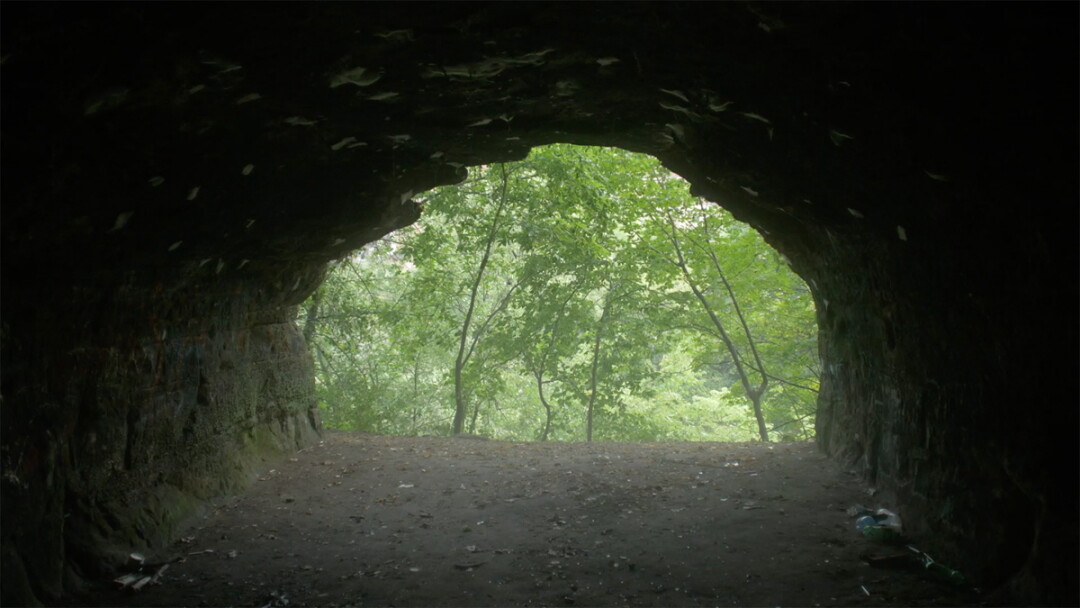Out of the Darkness
local author details the story of Eau Claire’s infamous ‘Cave Lady’
Emily Kuhn, photos by Andrea Paulseth |
Emily Kuhn, photos by Andrea Paulseth |

As we learned when she was featured in this very magazine following the publication of her first book, Eau Claire author Jane Glenz enjoys digging for facts. In The Moore Family Secret, Glenz follows former Tainter Lake resident Andrew Moore as he relocates from Texas to a farm in what is now Dunn County, along with almost a dozen slaves. As Glenz shared in that 2014 article, the research process her first book required was time-consuming and meticulous – and she loved it. Two books later, that love hasn’t wavered.
“The moment I heard of her, I wanted to write about her.” – Jane Glenz, on Maud Phillips a.k.a. “The Cave Lady”
Her newest work, The Cave Lady, follows the January 1918 insanity trial of Maud Phillips, also known as Violet Leigh. Phillips was a poet who lived with her family in a cave on the south bank of the Eau Claire River for six months in 1917. For this and other reasons – including habitual truancy, child neglect, and extramarital affairs – Eau Claire city officials sought to have Phillips committed.
Although most of Glenz’s book covers Phillips’ three-day trial, readers will also learn about Phillips’ early life, the early years of her marriage to Wilbur Phillips, even the lives of District Attorney Julius Gilbertson, attorney Andrew Sutherland, and Judge George Blum. To capture not only the facts of the trial but the spirit of Phillips herself, Glenz dedicated herself to the research process.
“I enjoy researching, and that’s good because it took me almost three years to find enough information to write this book,” Glenz said. Fortunately, Glenz’s lifestyle lends itself to long periods of study. A former history teacher and school administrator, she retired in 2004 and enjoys spending time examining local genealogy and history.
The computer is where Glenz found the key element of her story: Transcribed interviews of Phillips from each day of her public trial.
“Some of the conversations, particularly the personal ones, were made up. I’ve never met Maud, after all,” said Glenz. “But when Maud was on the stand, during the trial, the reporters’ notes were printed word-for-word in the newspaper … everything she said – even her statements about the men she’d been with – were printed right there for everyone to read.”

Those printed statements enabled Glenz to recreate conversations between Phillips, her lawyer, the judge, and her family throughout the book’s 14 chapters. What’s more, they helped ensure that Glenz maintained the integrity of her story.
“I try to be as accurate as I can,” said Glenz. “We hear too many false statements on TV about history; we should know the truth. And the truth makes the story more interesting to read.”
According to Glenz, that’s precisely her goal: Tell the truth about local history in a manner that engages readers, ideally young readers, into learning more.
“That’s how I got into history,” said Glenz. “I’ll never forgot my high school history teacher, who would stand in front of the class for hours, tossing his chalk up into the air and telling stories.”
Glenz chooses to write about topics that catch her attention, and Phillips’ story is definitely interesting. Not only did Phillips move her family to a cave, but she refused to send her children to school; she had extramarital affairs, including one with an Altoona minister; and she dedicated herself to entertaining the community by regularly submitting poems and letters for publication. As Glenz writes on the first page of her book, Phillips was simultaneously “content with life, socially popular, extraordinarily clever … and insane.”
“The moment I heard of her, I wanted to write about her,” Glenz said. “My dream is that students will read this story and become interested in local history. That’s why I like to tell history as a story instead of a boring history book. … I want people to find out more about local history.”
The Cave Lady covers the end of Phillips’ trial – and the decision the jury reached – as well as Glenz’ efforts to locate additional information on Phillips, her husband, and her children following the end of the trial … but you’ll have to read the book to learn what she discovered.
The Cave Lady is available at The Local Store (205 N. Dewey St., Eau Claire) and at the Chippewa Valley Museum (1204 E. Half Moon Drive, Eau Claire).